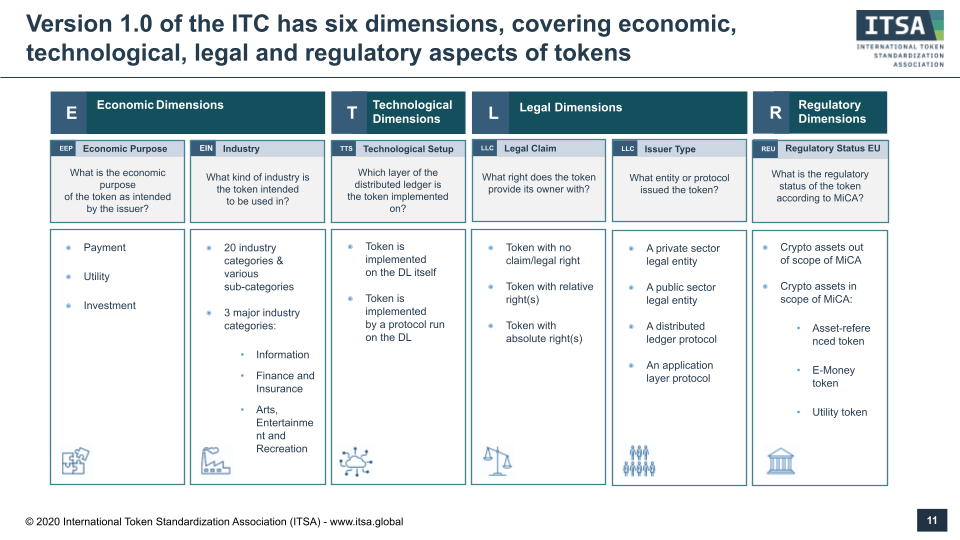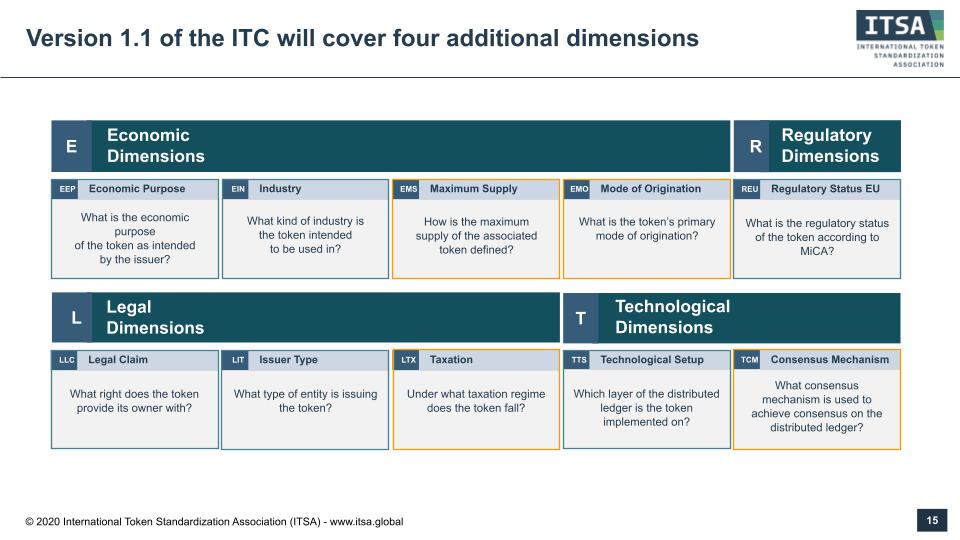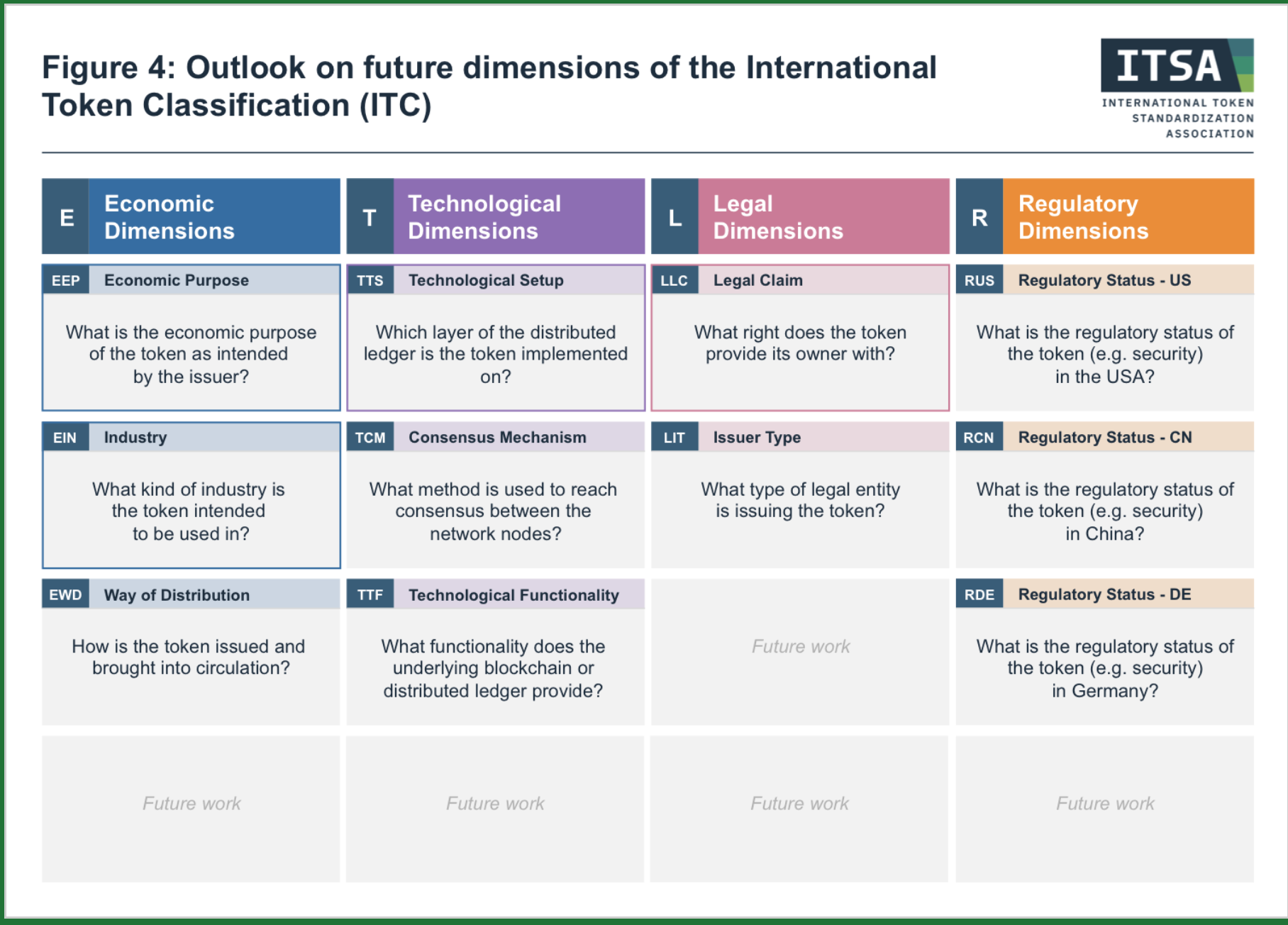Classification: International Token Classification (ITC)
Building upon ITIN as an identification standard for cryptographic tokens, ITSA also provides a holistic and flexible token classification standard: the International Token Classification (ITC).
As a guidance tool for the global token markets the ITC framework has already been applied to 1000+ cryptographic tokens and shall provide clarity and transparency on their characteristics in various dimensions. This can be particularly helpful for regulators that need a tangible framework for the differentiation of tokens, but also for institutional investors that seek to define investment strategies.
Token issuers can use the ITC framework to communicate their token’s characteristics clearly and conveniently towards investors and users. Users, once familiar with the ITC framework, should be enabled to grasp a classified token’s properties within seconds.
The first version of the framework (ITC v.0.9) has been published in 2019 in collaboration with independent scholars as well as industry experts under the lead of the Frankfurt School Blockchain Center (FSBC), which is an associated founding member of ITSA. The ITC V.0.9 covered economic (E), technological (T), and legal (L) aspects of DLT- and blockchain-based cryptographic tokens in four dimensions.
The second release of the framework (ITC v.1.0) has been developed throughout the year of 2020 by the International Token Standardization Association’s ITC Working Group (PWG2). It updates the ITC v.0.9 in order to take account of novel market trends, such as the development of a vibrant Decentralized Finance (DeFi) ecosystem, the growing importance and variety of stablecoins, as well as the growing interconnectedness and interoperability of different Distributed Ledgers.
Below you'll find an example of the stablecoin USD Coin classified based on the six dimensions of the ITC framework

Classification of the USD Coin which can be accessed through the Tokenbase. Link: https://itin.itsa.global/W9P03QJ63
In comparison to the previous version, two new dimensions have been added to the existing four (Economic Purpose, Issuer Industry, Technological Setup, and Legal Claim), which also face major updates, mostly with regard to the degree of detail and differentiation provided but also with regard to structural aspects. The two new dimensions allow to differentiate a Token according to the nature of its Issuer (Issuer Type) as well as according to its perceived regulatory status in the EU (Regulatory Status EU) based on the European Commission’s proposal for a regulation on Markets in Crypto Assets (MiCA, EU Regulation Proposal COM/2020/593 final).
As the overall changes to the framework turned out to be quite significant in comparison to v.0.9, all Tokens in the International Token Database (TOKENBASE) did undergo a reclassification.
In case you are interested in working with the ITC Working Group on the next updates of the framework or the classification of tokens, please reach out to Constantin Ketz, ITSA Vice Chairman ([email protected]).
Future updates will be carried out under supervision of ITSA and its members. The ITC is based on the current research landscape and incorporates relevant findings of various other classification approaches.
In Figure 1 you can an overview of the six dimensions that are covered by the ITC V1.0

Figure 1
Dimension 1: Economic Purpose (EEP)
The first dimension is constituted by the Economic Purpose of the token and asks for the token’s raison d’être from the issuer’s perspective. The dimension currently comprises three major categories: Payment Tokens (EEP21), Utility Tokens (EEP22) and Investment Tokens (EEP23). Payment Tokens are defined as tokens that are primarily created for the use as digital currencies that are not limited to a specific environment (e.g. a specific platform, online shop or ecosystem). As such, the ITC category Payment Token (EEP21) captures many cryptographic tokens, which are currently widely considered as cryptocurrencies (e.g. Bitcoin or XRP), yet excludes others that are perceived as cryptocurrencies by the wider public but have not been created with the sole purpose of functioning as a means of payment (e.g. Ethereum or EOS). Due to the fact that “cryptocurrency” is a collective term for all sorts of tokens and lacks clear definition, the ITC foregoes to use it completely. The category Utility Token (EEP22) comprises all types of tokens that are created to provide any sort of utility within a predefined environment (e.g. access to services or products, transaction settlement, governance functions, or ownership management). As a consequence, the ITC category of utility tokens is very diverse and often features tokens that possess more than one utility attribute. In these cases, the token is for now classified according to the most important characteristic (e.g. Ethereum and EOS are classified as utility settlement tokens due to their major function as means of transaction settlement within the Ethereum and EOS ecosystems). Investment Tokens (EEP23) represent cryptographic tokens that serve as a means of investment to the token holder (e.g. equity, debt or derivative tokens). In current market language most of these tokens are likely to be labelled as “security tokens”. However, in contradiction to current market practice, ITSA refrains from labelling such tokens as security tokens in this dimension, since the term is not focussing on the economic purpose of a token but on its regulatory status. Moreover, since many jurisdictions have no proper ruling yet on what is to be considered a security token, and since the ITC is designed to be applicable globally and regardless of any specific jurisdiction on which a regulatory status is always dependent, the first version of the ITC does not cover the regulatory status of cryptographic tokens at all. The idea is to add further dimensions focusing on the regulatory status of cryptographic tokens in various jurisdictions in future versions of the ITC whenever there is regulatory clarity. This approach also allows for the classification of tokens as security or non-security tokens independent of their classification according to their Economic Purpose, which is important since some regulators might not only consider Investment Tokens but also certain Utility Tokens or even Payment Tokens as securities.
Dimension 2: Industry (EIN)
The industry that a token is intended to be used in by the issuer represents the second dimension of the ITC. The dimension’s categories are rather broad and generic since they are based on the North American Industry Classification System (NAICS) for facilitated adoption and comparability. The sub-categories, however, are designed according to the characteristics of the global token economy and allow for improved differentiation between cryptographic tokens with regards to their specific fields of use. By default, Payment Tokens and Investment Tokens would be assigned for instance to the industry category Finance and Insurance (EIN10) and the respective industry sub-categories Payment Services (EIN10A) and Investment Services (EIN10D). Yet, since this allocation does not add any significantly new information beyond what is already covered in the dimension Economic Purpose (EEP), Payment Tokens and Investment Tokens can also be reassigned to other industries where appropriate. This could be the case for example, where a Payment Token is intended to serve as currency in esports and thus is reassigned to the industry sub-category Entertainment and Gaming (EIN17B). Moreover, for debt and equity tokens the industry of the company issuing debt or equity is usually considered as the industry of the token.
Dimension 3: Technological Setup (TTS)
The Technological Setup Dimension forms part of the Technological Dimensions Group and describes how a Token is implemented and deployed. The Dimension is split in two major Categories: Ledger-Native Tokens (TTS41), which form an integral part of a Distributed Ledger and are implemented by a Distributed Ledger Protocol (see Terminology), and Application Layer Tokens (TTS42), which are implemented by an Application Layer Protocol (see Terminology) on top of a Distributed Ledger. As part of the ITC update, the Category of Ledge-Native Tokens now comprises Subcategories differentiating between Blockchain-Native Tokens (TTS41BC) and DAG-Native Tokens (TTS41DG), as the most prominent types of Distributed Ledger Protocols. Moreover, the Category of Application Layer Tokens now comprises Subcategories covering the major Distributed Ledger Protocols that allow for the deployment of non-native Application Layer Token (e.g. Ethereum, Binance, Stellar, EOS, TRON, etc.), with their respective non-native Token standards as Classes (e.g. the ERC-20 Token Standard on the Ethereum Blockchain, or the BEP-2 on the Binance Chain / Binance Smart Chain).
Dimension 4: Legal Claim (LLC)
The type of legal claim, which a cryptographic token does entitle its owner to, forms the third dimension of the ITC framework. This dimension can be regarded as a preliminary step to future ITC dimensions on the regulatory status of a cryptographic token in various jurisdictions, as the analysis of the rights, which a token provides its owner with, mostly forms part of any regulatory assessment. The dimension features three categories: No-Claim Tokens (LLC31), Relative Rights Tokens (LLC32) and Absolute Rights Tokens (LLC33). While a No-Claim Token does not entitle its owner to any other right than to the token itself, a Relative Rights Token provides certain rights against at least one natural or legal counterparty (e.g. the right to the payment of interest and principal by a third party in case of a Debt Token, or the specified right to access and use a certain platform run by a third party in case of an Access Token). An Absolute Rights Token provides its owner with a right that is not dependent on a third party but exists independently. For instance, ownership rights in intellectual property are an absolute right, which can be managed and transferred through an Absolute Rights Token. In general, most cryptographic tokens currently on the market are No-claim Tokens due to the decentralized nature of their ecosystems and the lack of a third party that a claim could be raised against. Moreover, most jurisdictions currently still do not allow for the management and transfer of absolute rights through blockchains.
Dimension 5: Issuer Type (LIT)
The Issuer Type Dimension is a new Dimension, which also forms part of the Legal Dimensions Group and describes the nature of the Issuer (see Terminology) of a Token. The Dimension has been added as part of the ITC v.1.0 update in order to cater to the developments with respect to Central Bank Digital Currencies (CBDCs) and national stablecoins on the one hand, and to novel trends in Decentralized Finance (DeFi) and decentralization in general on the other. On Category Level, the Dimension is divided into Issuers represented by a Legal Entity (LIT61) and Issuers without legal personality (LIT62). Whereas the first Category is further split up into Private Sector Legal Entities (LIT61PV) in the form of public and private companies, associations, foundations, or partnerships as well as Public Sector Legal Entities (LIT61PC) that capture central banks, ministries or government agencies, the second Category of Entities without Legal Personality captures all Issuers of Tokens which are not clearly identifiable or tangible. Such Issuers can tak shape of fluid groups of individuals, network nodes and/or other Token stakeholders that jointly run and/or maintain an otherwise largely autonomous software protocol, which is deploying the Token in a fully decentralized manner. Since in such cases the software protocol deploying a Token appears often to be the only tangible object that can be related to, this framework integrates autonomously running software protocols as Issuers of a Token by definition, thereby differentiating between Distributed Ledger Protocols (LIT6102DL) and Application Layer Protocols (LIT6102AL) as Subcategories of the Category Entity without Legal Personality.
Dimension 6: Technological Setup (TTS)
The Technological Setup, as the fourth and currently last dimension of the ITC, describes the technological properties of a cryptographic token and asks for the level of its implementation. The ITC differentiates between two major categories: Ledger-Native Tokens (TTS41) and Non-Native Protocol Tokens (TTS42). The first category (TTS41) represents all tokens that are directly implemented on the blockchain or any other distributed ledger and hence function as an integral part of the respective ledger. For example, Bitcoin is a native token issued on the Bitcoin blockchain. By means of sub-categories, future versions of the ITC will also distinguish between the type of ledger that the token is implemented on (e.g. blockchain, directed acyclic graph (DAG), etc.). The second category (TTS42) comprises all tokens that are not created on the ledger-level but on the protocol-level on top of an existing blockchain or distributed ledger. Here, sub-categories differentiate between the type of protocols (e.g. ERC20). For example, the Basic Attention Token is a Non-Native Protocol Token that builds on the ERC20 standard protocol. The Technological Setup of a cryptographic token is not only an interesting dimension for academics and developers, but it is also an important parameter for its risk and value assessment.
Future Outlook
Currently ITSA and its members are working on Version 1.1 of the ITC which will cover four additional dimensions (Figure 2).
Dimension 7: Consensus Mechanism (TCM)
The Dimension Consensus Mechanism forms part of the Technological Dimensions Group and describes the mechanism that is deployed to achieve consensus on the token’s distributed ledger. The dimension is split into three different categories: Proof-based Consensus Mechanisms (leader-based), Voting-based Consensus Mechanisms, and Hybrid Consensus Mechanisms, which include hybrid mechanisms of proof-based as well as voting-based consensus. The category Proof-based Consensus Mechanism compromises the two subcategories Proof-of-Work and Proof-of Stake, the category Hybrid Consensus compromises the subcategory Delegated Proof-of-Stake, and the category Voting-based Consensus Mechanism compromises the three subcategories Byzantine Fault Tolerant, Crash Fault Tolerant and Gossip-Voting. Consensus Mechanisms have proven to be at the center of DLT related research regarding the trilemma of decentralization, security, and scalability. The addition of consensus mechanisms as part of the ITC 1.1 therefore adds to the general understanding of a token’s specific features such as rewards, security, and transactions per seconds.
Dimension 8: Maximum Supply (EMS)
The Dimension Type of Maximum Supply forms part of the Economic Dimensions Group and describes the token’s type of maximum supply. The dimension is split into two different categories: Fixed, which refers to token with a fixed maximum supply (encoded in the protocol of the network or the smart contract), and Flexible, which refers to flexible maximum supply. Moreover, the category Flexible compromises three subcategories: Inflationary, which refers to a permanently increasing maximum token supply, Deflationary, which refers to a permanently decreasing maximum token supply, and Discretionary, which refers to a flexible maximum token with increases and decreases.
Dimension 9: Mode of Origination (EMO)
The Dimension Mode of Origination forms part of the Economic Dimensions Group and describes how the majority (>50%) of the circulating token supply got allocated to its owners. The Dimension is split into four different categories: Reward, Sale, Airdrop, and Other. The category Rewards compromises all token allocations based on rewards for an effort such as mining and staking. The category Sale compromises all token allocations based on private or public sales such as Initial Token Offerings (ICOs) and Security Token Offerings (STOs). The third category Airdrop compromises all token allocations which were based on community driven airdrops such as BadgerDAO.
Dimension 10: Taxation (LTX)
Common categories and types of crypto-assets are: (i) Payment tokens (i.e. virtual currencies), (ii) Security (or Asset and Financial) tokens and (iii) Utility (or Consumer) tokens. This three-tiered classification system is a good classification on international level. However, across jurisdictions these categories may be interpreted differently, which may result in a different classification of assets and different tax implications. In addition, some crypto-assets cannot be classified under any of these categories and some crypto-assets can be classified under multiple categories (OECD, 2020; Cambridge Centre for Alternative Finance, 2019). Therefore a classification still lacks a clear and specific statement on their regulatory treatment.
One common distinction can be drawn between crypto-assets: those crypto-assets that resemble 'conventional' assets, like securities, and which are merely recorded on DLT systems (Conventional Asset Tokens DTA71), and those assets and activities that raise new regulatory challenges such as virtual currencies (New Asset Tokens DTA 72; OECD 2020). While the first class can be classified accordingly, new concepts need to be found in the latter

Figure 2
In general, the ITC framework is designed with the aim of giving clear guidance and structure while at the same time avoiding rigidity and facilitating the incorporation of future market developments. Therefore, future versions of the ITC will not only include new dimensions such as the regulatory status of a cryptographic token in different jurisdictions or the way of a token’s distribution, but will also feature new levels of detail in each dimension by adding further classes within the sub-categories.
An outlook is given in Figure 4.

Updated over 3 years ago